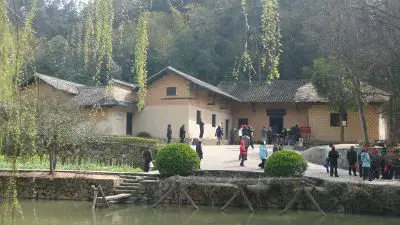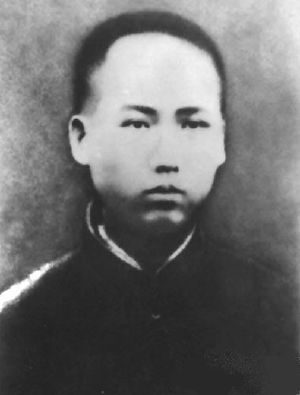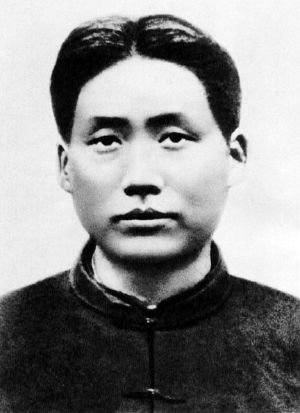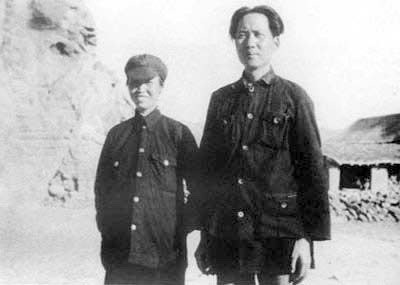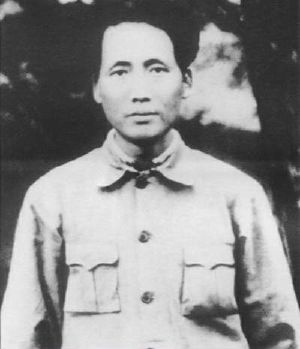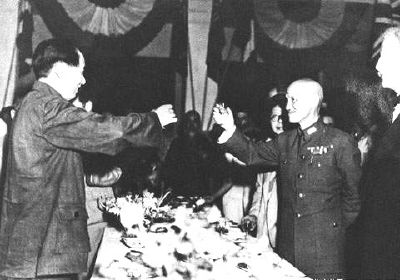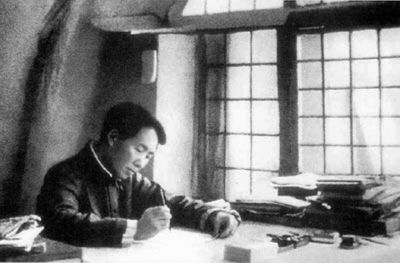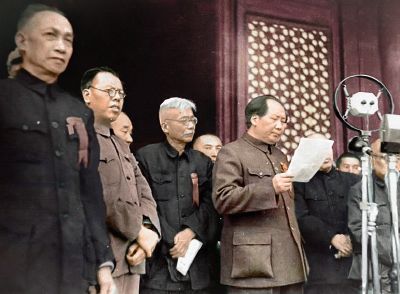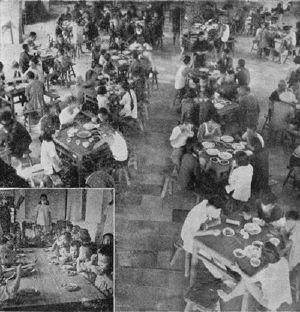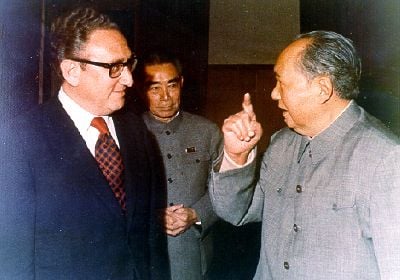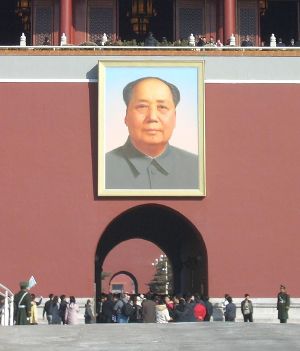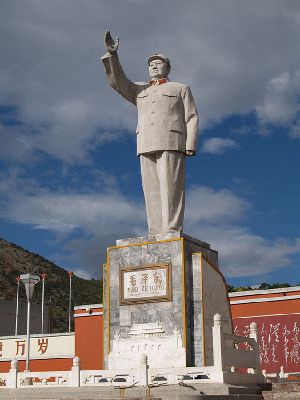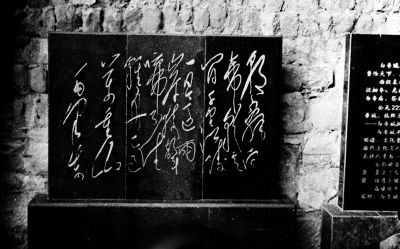Mao Zedong
- This is a Chinese name; the family name is Mao.
| Mao Zedong | |
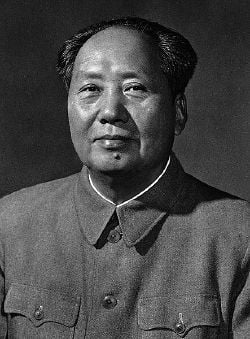 Official portrait, 1959 | |
1st Chairman of the Central Committee of the Communist Party of China
| |
| Preceded by | Himself (as Central Politburo Chairman) |
|---|---|
| Succeeded by | Hua Guofeng |
| Preceded by | Zhang Wentian (as Central Committee General Secretary) |
| Succeeded by | Himself (as Central Committee Chairman) |
1st Chairman of the CPC Central Military Commission
| |
1st Chairman of the National Committee of the CPPCC
| |
| Preceded by | Position created |
| Succeeded by | Zhou Enlai |
1st Chairman of the People's Republic of China
| |
| In office September 27, 1954 – April 27, 1959 | |
| Deputy | Zhu De |
| Preceded by | Position created |
| Succeeded by | Liu Shaoqi |
| Born | December 26 1893 Shaoshan, Hunan |
| Died | September 9 1976 (aged 82) Beijing |
| Political party | Communist Party of China |
| Spouse | Luo Yixiu (1907–1910) Yang Kaihui (1920–1930) He Zizhen (1930–1937) Jiang Qing (1939–1976) |
| Children | 10 |
| Occupation | Revolutionary, statesman |
| Religion | None (atheist) |
| Signature | |
Mao Zedong, also transliterated as Mao Tse-tung, and commonly referred to as Chairman Mao (December 26, 1893 - September 9, 1976), was a Chinese communist revolutionary and a founding father of the People's Republic of China, which he governed as Chairman of the Communist Party of China from its establishment in 1949 until his death. His Marxist-Leninist theories, military strategies, and political policies are collectively known as Maoism.
Born the son of a wealthy farmer in Shaoshan, Hunan, Mao adopted a Chinese nationalist and anti-imperialist outlook in early life. He converted to Marxism-Leninism and became a founding member of the Communist Party of China (CPC), of which he became the head during the Long March. On October 1, 1949 Mao proclaimed the foundation of the People's Republic of China. In the following years he solidified his control through land reforms, through a psychological victory in the Korean War, and through campaigns against landlords, people he termed "counterrevolutionaries," and other perceived enemies of the state. In 1957 he launched a campaign known as the Great Leap Forward that aimed to rapidly transform China's economy from an agrarian economy to an industrial one. This campaign, however, exacerbated agrarian problems leading to one the deadliest famines in history. In 1966, he initiated the Cultural Revolution, a program to weed out supposed counter-revolutionary elements in Chinese society. In 1972, he welcomed American president Richard Nixon in Beijing, signaling a policy of opening China.
| Mao Zedong | |||||||||||||||||||||
|---|---|---|---|---|---|---|---|---|---|---|---|---|---|---|---|---|---|---|---|---|---|
| Simplified Chinese: | 毛泽东 | ||||||||||||||||||||
| Traditional Chinese: | 毛澤東 | ||||||||||||||||||||
| Hanyu Pinyin: | Máo Zédōng | ||||||||||||||||||||
| |||||||||||||||||||||
| This article contains Chinese text. Without proper rendering support, you may see question marks, boxes, or other symbols instead of Chinese characters. |
A highly controversial figure, Mao is regarded as one of the most important individuals in modern world history. Supporters regard him as a great leader and credit him with numerous accomplishments including modernizing China and building it into a world power, promoting the status of women, improving education and health care, providing universal housing, and increasing life expectancy as China's population grew from around 550 to over 900 million during the period of his leadership. In contrast, critics, including many historians, have characterized him as a dictator who oversaw systematic human rights abuses, and whose rule is estimated to have contributed to the deaths of 40–70 million people through starvation, forced labor, and executions, ranking his tenure as the top incidence of democide in human history.
Early life
Mao was born on December 26, 1893 in Shaoshan village, Shaoshan, Hunan. His father, Mao Yichang, was an impoverished peasant who had become one of the wealthiest farmers in Shaoshan. Zedong described his father as a stern disciplinarian, who would beat him and his three siblings, the boys Zemin and Zetan, and an adopted girl, Zejian.[1] Yichang's wife, Wen Qimei, was a devout Buddhist who tried to temper her husband's strict attitude. Zedong too became a Buddhist, but abandoned this faith in his mid-teenage years.[2]
At the age of eight, Mao was sent to Shaoshan Primary School where he learned the value systems of Confucianism. He later admitted that he did not enjoy the classical Chinese texts preaching Confucian morals, instead favoring popular novels like Romance of the Three Kingdoms and Water Margin.[3]
Mao finished primary education at the age of 13 and his father had him married to the 17-year-old Luo Yixiu, uniting their land-owning families. Mao refused to recognize her as his wife, becoming a fierce critic of arranged marriage and temporarily moving away. Luo was locally disgraced and died in 1910.[4] Aged 16, Mao moved to a higher primary school in nearby Dongshan, where he was bullied for his peasant background.[1]
Working on his father's farm, Mao read voraciously, developing a "political consciousness" from Zheng Guanying's booklet which lamented the deterioration of Chinese power and argued for the adoption of representative democracy. Mao was inspired by the military prowess and nationalistic fervor of George Washington and Napoleon Bonaparte.[3] His political views were shaped by Gelaohui-led protests which erupted following a famine in the Hunanese capital Changsha. Mao supported the protester's demands, but the armed forces suppressed the dissenters and executed their leaders.[1] The famine spread to Shaoshan, where starving peasants seized his father's grain. Disapproving of their actions as morally wrong, Mao nevertheless claimed sympathy for their situation.[2]
After moving to Changsha, Mao enrolled and dropped out of a police academy, a soap-production school, a law school, an economics school, and the government-run Changsha Middle School. Studying independently, he spent much time in Changsha's library, reading core works of classical liberalism such as Adam Smith's The Wealth of Nations and Montesquieu's The Spirit of the Laws, as well as the works of western scientists and philosophers such as Darwin, Mill, Rousseau, and Spencer.[2] Viewing himself as an intellectual, he admitted years later that at this time he thought himself better than working people.[3]
Mao decided to become a teacher and enrolled at the Fourth Normal School of Changsha, which soon merged with the First Normal School of Changsha, widely seen as the best school in Hunan. Professor Yang Changji befriended Mao and urged him to read a radical newspaper, New Youth (Xin qingnian), the creation of his friend Chen Duxiu, a dean at Peking University. Mao published his first article in New Youth in April 1917, instructing readers to increase their physical strength to serve the revolution. He joined the Society for the Study of Wang Fuzhi (Chuan-shan Hsüeh-she), a revolutionary group founded by Changsha literati who wished to emulate the philosopher Wang Fuzhi.[2]
Seeing no use in his son's intellectual pursuits, Mao's father had cut off his allowance, forcing him to move into a hostel for the destitute.[5] In his first school year, Mao befriended an older student, Xiao Yu; together they went on a walking tour of Hunan, begging and writing literary couplets to obtain food.[6] In 1915 Mao was elected secretary of the Students Society. Forging an Association for Student Self-Government, he led protests against school rules. In spring 1917, he was elected to command the students' volunteer army, set up to defend the school from marauding soldiers. Increasingly interested in the techniques of war, he took a keen interest in World War I, and also began to develop a sense of solidarity with workers.[3] Mao undertook feats of physical endurance with Xiao Yu and Cai Hesen, and with other young revolutionaries they formed the Renovation of the People Study Society in April 1918 to debate Chen Duxiu's ideas. The Society gained 70–80 members, many of whom would later join the Communist Party. Mao graduated in June 1919, ranked third in the year.[1]
Mao moved to Beijing and, paid a low wage, lived in a cramped room with seven other Hunanese students. He believed that Beijing's beauty offered "vivid and living compensation."[3] His time in Beijing ended in the spring of 1919, when he traveled to Shanghai with friends departing for France, before returning to Shaoshan, where his mother was terminally ill; she died in October 1919, with her husband dying in January 1920.[3]
Early revolutionary activity
Mao adopted a Chinese nationalist and anti-imperialist outlook in early life, particularly influenced by the events of the Xinhai Revolution of 1911 and May Fourth Movement of 1919. He converted to Marxism-Leninism while working at Peking University and became a founding member of the Communist Party of China (CPC).
The Xinhai Revolution
The Xinhai Revolution of 1911 overthrew China's last imperial dynasty (the Qing dynasty), and established the Republic of China (ROC). In Changsha there was widespread animosity towards Emperor Puyi's absolute monarchy, with many advocating republicanism. The republicans' figurehead was Sun Yat-sen, an American-educated Christian who led the Tongmenghui society.[5] Mao was influenced by Sun's newspaper, The People's Independence (Minli bao), and called for Sun to become president in a school essay.[1] As a symbol of rebellion against the Manchu monarch, Mao and a friend cut off their queue pigtails, a sign of subservience to the emperor.[2]
Mao joined the rebel army as a private soldier, but was not involved in fighting. When the revolution was over in 1912, he resigned from the army after six months of being a soldier.[3] Around this time, Mao discovered socialism from a newspaper article; proceeding to read pamphlets by Jiang Kanghu, the student founder of the Chinese Socialist Party, Mao remained interested yet unconvinced by the idea.[1]
Beijing: Student rebellions
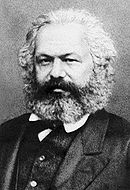
|
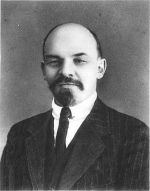
| |
Following the success of the October Revolution in the Russian Empire, in which Marxists took power, Mao came under the theoretical influence of Karl Marx (left) and Lenin (right).
| ||
Mao moved to Beijing where his mentor Yang Changji had taken a job at Peking University. Yang thought Mao exceptionally "intelligent and handsome," securing him a job as assistant to the university librarian Li Dazhao, an early Chinese communist.[4] Li authored a series of New Youth articles on the October Revolution in Russia, during which the communist Bolshevik Party under the leadership of Vladimir Lenin had seized power. Becoming "more and more radical," Mao was influenced by Peter Kropotkin's anarchism but joined Li's Study Group and "developed rapidly toward Marxism" during the winter of 1919.[1]
In May 1919, the May Fourth Movement erupted in Beijing, with Chinese patriots rallying against the Japanese and Duan's Beiyang Government. Duan's troops were sent in to crush the protests, but unrest spread throughout China. Mao began organizing protests against the pro-Duan Governor of Hunan Province, Zhang Jinghui, popularly known as "Zhang the Venomous" due to his criminal activities. He co-founded the Hunanese Student Association with He Shuheng and Deng Zhongxia, organizing a student strike for June and in July 1919 began production of a weekly radical magazine, Xiang River Review (Xiangjiang pinglun). Using vernacular language that would be understandable to the majority of China's populace, he advocated the need for a "Great Union of the Popular Masses." His ideas at that time were not Marxist, but heavily influenced by Kropotkin's concept of mutual aid.[3]
Zhang banned the Student Association, but Mao continued publishing after assuming editorship of liberal magazine New Hunan (Xin Hunan) and offering articles in popular local newspaper Justice (Ta Kung Po). Several of these articles advocated feminist views, calling for the liberation of women in Chinese society. In this, Mao was influenced by his forced arranged marriage.[1] In December 1919, Mao helped organize a general strike in Hunan, securing some concessions, but Mao and other student leaders felt threatened by Zhang, and Mao returned to Beijing, visiting the terminally ill Yang Changji. Mao found that his articles had achieved a level of fame among the revolutionary movement, and set about soliciting support in overthrowing Zhang. Coming across newly translated Marxist literature by Thomas Kirkup, Karl Kautsky, and Marx and Engels—notably The Communist Manifesto—he came increasingly under their influence, but was still eclectic in his views.[3]
Mao visited Tianjin, Jinan, and Qufu, before moving to Shanghai, where he met Chen Duxiu. He noted that Chen's adoption of Marxism "deeply impressed me at what was probably a critical period in my life."[3] In Shanghai, Mao met his old teacher, Yi Peiji, a revolutionary and member of the Kuomintang (KMT), or Chinese Nationalist Party, which was gaining increasing support and influence. Yi introduced Mao to General Tan Yankai, a senior KMT member who held the loyalty of troops stationed along the Hunanese border with Guangdong. Tan was plotting to overthrow Zhang, and Mao aided him by organizing the Changsha students. In June 1920, Tan led his troops into Changsha, while Zhang fled. In the subsequent reorganization of the provincial administration, Mao was appointed headmaster of the junior section of the First Normal School. With a secure income, he married Yang Kaihui in the winter of 1920.[1]
Founding the Communist Party of China
In 1921 Chen Duxiu and Li Dazhao founded the Communist Party of China as a study society and informal network. Mao set up a Changsha branch and opened a bookstore for the purpose of propagating revolutionary literature throughout Hunan.
By 1921, small Marxist groups existed in Shanghai, Beijing, Changsha, Wuhan, Canton, and Jinan, and it was decided to hold a central meeting, which began in Shanghai on July 23, 1921. This first session of the National Congress of the Communist Party of China was attended by 13 delegates, Mao included, and met in a girls' school that was closed for the summer. After the authorities sent a police spy to the congress, the delegates moved to a boat on South Lake near Chiahsing to escape detection.
Now party secretary for Hunan, Mao was stationed in Changsha, from which he went on a Communist recruitment drive. In August 1921, he founded the Self-Study University, through which readers could gain access to revolutionary literature, housed in the premises of the Society for the Study of Wang Fuzhi. Taking part in the Chinese National YMCA mass education movement to fight illiteracy, he opened a Changsha branch, though replaced the usual textbooks with revolutionary tracts in order to spread Marxism among the students. He continued organizing the labor movement to strike against the administration of Hunan Governor Zhao Hengti. In July 1922, the Second Congress of the Communist Party took place in Shanghai. Adopting Lenin's advice, the delegates agreed to an alliance with the "bourgeois democrats" of the KMT for the good of the "national revolution." Communist Party members joined the KMT, hoping to push its politics leftward. Mao enthusiastically agreed with this decision, arguing for an alliance across China's socio-economic classes.
Collaboration with the Kuomintang
At the Third Congress of the Communist Party in Shanghai in June 1923, the delegates reaffirmed their commitment to working with the KMT against the Beiyang government and imperialists. Supporting this position, Mao was elected to the Party Committee, taking up residence in Shanghai. Attending the First KMT Congress, held in Guangzhou in early 1924, Mao was elected an alternate member of the KMT Central Executive Committee, and put forward four resolutions to decentralize power to urban and rural bureaus. His enthusiastic support for the KMT earned him the suspicion of some communists.[1] In late 1924, Mao returned to Shaoshan to recuperate from an illness. Discovering that the peasantry were increasingly restless due to the upheaval of the past decade (some had seized land from wealthy landowners to found communes) he became convinced of the revolutionary potential of the peasantry. As a result, Mao was appointed to run the KMT's Peasant Movement Training Institute, also becoming Director of its Propaganda Department and editing its Political Weekly (Zhengzhi zhoubao) newsletter.[4]
Through the Peasant Movement Training Institute, Mao took an active role in organizing the revolutionary Hunanese peasants and preparing them for militant activity, taking them through military training exercises and getting them to study various left-wing texts. In the winter of 1925, Mao fled to Canton after his revolutionary activities attracted the attention of Zhao's regional authorities.
When KMT party leader Sun Yat-sen died in May 1925, he was succeeded by a rightist, Chiang Kai-shek, who initiated moves to marginalize the position of the communists. Mao nevertheless supported Chiang's decision to overthrow the Beiyang government and their foreign imperialist allies using the National Revolutionary Army, who embarked on the Northern Expedition in 1926. In the wake of this expedition, peasants rose up, appropriating the land of the wealthy landowners, many of whom were killed. Such uprisings angered senior KMT figures, who were themselves landowners, emphasizing the growing class and ideological divide within the revolutionary movement.
In March 1927, Mao appeared at the Third Plenum of the KMT Central Executive Committee in Wuhan, which sought to strip General Chiang of his power by appointing Wang Jingwei leader. There, Mao played an active role in the discussions regarding the peasant issue, defending a set of "Regulations for the Repression of Local Bullies and Bad Gentry," which advocated the death penalty or life imprisonment for anyone found guilty of counter-revolutionary activity, arguing that in a revolutionary situation, "peaceful methods cannot suffice."[4] In April 1927, Mao was appointed to the KMT's five-member Central Land Committee, urging peasants to refuse to pay rent. Mao led another group to put together a "Draft Resolution on the Land Question," which called for the confiscation of land belonging to "local bullies and bad gentry, corrupt officials, militarists and all counter-revolutionary elements in the villages." [1]
Civil War
In 1927 Mao's Autumn Harvest Uprising showed the potential revolutionary power of the peasants. At the same time, the KMT's military leader Generalissimo Chiang Kai-shek mounted an anti-communist purge, setting off the Chinese Civil War.
The Nanchang and Autumn Harvest Uprisings
The CPC continued supporting the Wuhan KMT government, a position Mao initially supported, but he had changed his mind by the time of the CPC's Fifth Congress, deciding to stake all hope on the peasant militia.[5] The question was rendered moot when the Wuhan government expelled all communists from the KMT. The CPC founded the Workers' and Peasants' Red Army of China, better known as the "Red Army," to battle Chiang. A battalion led by General Zhu De was ordered to take the city of Nanchang on August 1, 1927 in what became known as the Nanchang Uprising; initially successful, they were forced into retreat after five days, marching south to Shantou, and from there being driven into the wilderness of Fujian.
Appointed commander-in-chief of the Red Army, Mao led four regiments against Changsha in the Autumn Harvest Uprising, hoping to spark peasant uprisings across Hunan. On the eve of the attack, Mao composed a poem—the earliest of his to survive—titled "Changsha." Mao's plan was to attack the KMT-held city from three directions on September 9, but the Fourth Regiment deserted to the KMT cause, attacking the Third Regiment. Mao's army made it to Changsha, but could not take it; by September 15 he accepted defeat, with 1,000 survivors marching east to the Jinggang Mountains of Jiangxi.[4]
The CPC Central Committee expelled Mao from their rank and from the Hunan Provincial Committee, punishment for his "military opportunism," for his focus on rural activity, and for being too lenient with "bad gentry." Setting up base in Jinggangshan City, an area of the Jinggang Mountains, Mao united five villages as a self-governing state, supporting the confiscation of land from rich landlords, who were "re-educated" and sometimes executed. He ensured that no massacres took place in the region, pursuing a more lenient approach than that advocated by the Central Committee.[1] Proclaiming that "Even the lame, the deaf and the blind could all come in useful for the revolutionary struggle," he boosted the army's numbers, incorporating two groups of bandits into his army, building a force of around 1,800 troops. He laid down rules for his soldiers: prompt obedience to orders, all confiscations were to be turned over to the government, and nothing was to be confiscated from poorer peasants. In doing so, he molded his men into a disciplined, efficient fighting force.[5]
In spring 1928, the Central Committee ordered Mao's troops to southern Hunan, hoping to spark peasant uprisings. Mao was skeptical, but complied. Reaching Hunan, they were attacked by the KMT and fled after heavy losses. Meanwhile, KMT troops had invaded Jinggangshan, leaving them without a base. Wandering the countryside, Mao's forces came across a CPC regiment led by General Zhu De and Lin Biao; they united and retook Jinggangshan after prolonged guerrilla war against the KMT. Joined by a defecting KMT regiment and Peng Dehuai's Fifth Red Army, the mountainous area was unable to grow enough crops to feed everyone, leading to food shortages throughout the winter.[4]
Jiangxi Soviet Republic of China
In January 1929, Mao and Zhu evacuated the base and took their armies south, to the area around Tonggu and Xinfeng in Jiangxi, which they consolidated as a new base. Together having 2,000 men, with a further 800 provided by Peng, the evacuation led to a drop in morale, and many troops became disobedient and began thieving; this worried Li Lisan and the Central Committee. Li believed that only the urban proletariat could lead a successful revolution, and saw little need for Mao's peasant guerrillas. Mao refused to disband his army or abandon his base. Officials in Moscow desired greater control over the CPC, removing Li from power by calling him to Russia for an inquest into his errors and replacing him with Soviet-educated Chinese communists, known as the "28 Bolsheviks," two of whom, Bo Gu and Zhang Wentian, took control of the Central Committee. Mao disagreed with the new leadership, believing they grasped little of the Chinese situation, and soon emerged as their key rival.[1]
In February 1930, Mao created the Southwest Jiangxi Provincial Soviet Government in the region under his control. In November his wife and sister were captured and beheaded by KMT general He Jian. Mao then married He Zizhen, an 18-year-old revolutionary who bore him five children over the following nine years.[4] Members of the Jiangxi Soviet accused him of being too moderate, and hence anti-revolutionary. In December, they tried to overthrow Mao, resulting in the Futian incident; putting down the rebels, Mao's loyalists tortured many and executed between 2,000 and 3,000 dissenters.[1] Seeing it as a secure area, the CPC Central Committee moved to Jiangxi, which in November was proclaimed to be the Soviet Republic of China, an independent Communist-governed state. Although proclaimed Chairman of the Council of People's Commissars, Mao's power was diminished, with control of the Red Army being allocated to Zhou Enlai; Mao meanwhile recovered from tuberculosis.[5]
Attempting to defeat the Communists, the KMT armies adopted a policy of encirclement and annihilation; outnumbered, Mao responded with guerrilla tactics, but Zhou and the new leadership replaced this approach with a policy of open confrontation and conventional warfare. In doing so the Red Army successfully defeated the first and second encirclements. Angered at his armies' failure, Chiang Kai-shek personally arrived to lead the operation; also facing setbacks, he retreated to deal with the further Japanese incursions into China. Victorious, the Red Army expanded its area of control, eventually encompassing a population of 3 million. Viewing the Communists as a greater threat than the Japanese, Chiang returned to Jiangxi, initiating the fifth encirclement campaign, involving the construction of a concrete and barbed wire "wall of fire" around the state, accompanied by aerial bombardment, to which Zhou's tactics proved ineffective. Trapped inside, morale among the Red Army dropped as food and medicine became scarce, and the leadership decided to evacuate.[4]
The Long March
On October 14, 1934, the Red Army broke through the KMT line on the Jiangxi Soviet's south-west corner at Xinfeng with 85,000 soldiers and 15,000 party cadres and embarked on the "Long March." In order to make the escape, many of the wounded and the ill as well as women and children, including Mao's two young children born to He Zizhen who accompanied Mao on the march, were left behind. They took Zunyi in January 1935 where they held a conference. Mao was elected to a position of leadership, becoming Chairman of the Politburo and de facto leader of both Party and Red Army, in part because his candidacy was supported by Soviet Premier Joseph Stalin. Insisting that they operate as a guerrilla force, Mao laid out a destination: the Shenshi Soviet in Shaanxi, Northern China, from where the Communists could focus on fighting the Japanese.
Mao led his troops to Loushan Pass, where they faced armed opposition but successfully crossed the river. Chiang flew into the area to lead his armies against Mao, but the Communists out-maneuvered him and crossed the Jinsha River. Faced with the more difficult task of crossing the Tatu River, they managed it by fighting a battle over the Luding Bridge in May, taking Luding. Marching through the mountain ranges around Ma'anshan, in Moukung, Western Szechuan they encountered the 50,000-strong CPC Fourth Front Army of Zhang Guotao, together proceeding to Maoerhkai and then Gansu. However, Zhang and Mao disagreed over what to do; the latter wished to proceed to Shaanxi, while Zhang wanted to flee east to Tibet or Sikkim, far from the KMT threat. It was agreed that they would go their separate ways, with Zhu De joining Zhang. Mao's forces proceeded north, through hundreds of miles of Grasslands, an area of quagmire where they were attacked by Manchu tribesman and where many soldiers succumbed to famine and disease. Finally reaching Shaanxi, they fought off both the KMT and an Islamic cavalry militia before crossing over the Min Mountains and Mount Liupan and reaching the Shenshi Soviet; only 7-8,000 had survived.[4]
While costly, the Long March gave the Communist Party of China (CPC) the isolation it needed, allowing its army to recuperate and rebuild in the north of China. The Chinese communists developed their ideology, their methods of indoctrination and their guerrilla tactics. The determination and dedication of the surviving participants of the Long March was vital in helping the CPC to gain a positive reputation among the peasants.
The Long March cemented Mao's status as the dominant figure in the party. In November 1935, he was named chairman of the Military Commission. From this point onward, Mao was the Communist Party's undisputed leader, even though he would not become party chairman until 1943.[7]
It should be noted that many of the events as later described by Mao and which now form the official story of the Communist Party of China, as told above, are regarded as lies by some historians. During the decade spent researching the book, Mao: The Unknown Story, for instance, Jung Chang found evidence that there was no battle at Luding and that the CCP crossed the bridge unopposed.[8]
Alliance with the Kuomintang
Arriving at the Yan'an Soviet during October 1935, Mao's troops settled in Pao An. Remaining there till spring 1936, they developed links with local communities, redistributed and farmed the land, offered medical treatment and began literacy programs.[4] Mao now commanded 15,000 soldiers, boosted by the arrival of He Long's men from Hunan and the armies of Zhu Den and Zhang Guotao, returning from Tibet. In February 1936 they established the North West Anti-Japanese Red Army University in Yan'an, through which they trained increasing numbers of new recruits. In January 1937 they began the "anti-Japanese expedition," sending groups of guerrilla fighters into Japanese-controlled territory to undertake sporadic attacks, while in May 1937, a Communist Conference was held in Yan'an to discuss the situation. Western reporters also arrived in the "Border Region" (as the Soviet had been renamed); most notable were Edgar Snow, who used his experiences as a basis for Red Star Over China, and Agnes Smedley, whose accounts brought international attention to Mao's cause.[1]
On the Long March, Mao's wife He Zizen had been injured from a shrapnel wound to the head, and so traveled to Moscow for medical treatment; Mao proceeded to divorce her and marry an actress, Jiang Qing. Mao moved into a cave-house and spent much of his time reading, tending his garden and theorizing.[5] He came to believe that the Red Army alone was unable to defeat the Japanese, and that a Communist-led "government of national defense" should be formed with the KMT and other "bourgeois nationalist" elements to achieve this goal. Although despising Chiang Kai-shek as a "traitor to the nation", on May 5 he telegrammed the Military Council of the Nanking National Government proposing a military alliance, a course of action advocated by Stalin.[1] Although Chiang intended to ignore Mao's message and continue the civil war, he was arrested by one of his own generals, Zhang Xueliang, in Xi'an, leading to the Xi'an Incident; Zhang forced Chiang to discuss the issue with the Communists, resulting in the formation of a United Front with concessions on both sides on December 25, 1937.[4]
In August 1938, the Red Army formed the New Fourth Army and the Eighth Route Army, which were nominally under the command of Chiang's National Revolutionary Army. In August 1940, the Red Army initiated the Hundred Regiments Campaign, in which 400,000 troops attacked the Japanese simultaneously in five provinces; a military success, it resulted in the death of 20,000 Japanese, the disruption of railways and the loss of a coal mine. From his base in Yan'an, Mao authored several texts for his troops, including Philosophy of Revolution, which offered an introduction to the Marxist theory of knowledge, Protracted Warfare, which dealt with guerrilla and mobile military tactics, and New Democracy, which laid forward ideas for China's future.
Resuming civil war
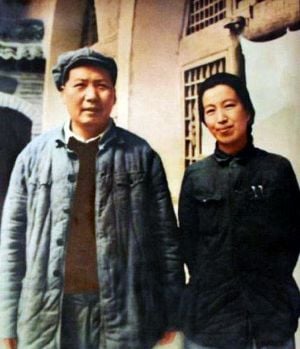
After the end of World War II, the U.S. continued their military assistance to Chiang Kai-shek and his KMT government forces against the People's Liberation Army (PLA) led by Mao in the civil war for control of China. In 1948, under direct orders from Mao, the People's Liberation Army starved out the Kuomintang forces occupying the city of Changchun. At least 160,000 civilians are believed to have perished during the siege, which lasted from June until October. On January 21, 1949, Kuomintang forces suffered great losses in battles against Mao's forces. In the early morning of December 10, 1949, PLA troops laid siege to Chengdu, the last KMT-held city in mainland China, and Chiang Kai-shek evacuated from the mainland to Formos (now Taiwan).[9]
Leadership of China
On October 1, 1949 Mao proclaimed the foundation of the People's Republic of China, a one-party socialist state controlled by the Communist Party. In the following years Mao solidified his control through land reforms, through a psychological victory in the Korean War, and through campaigns against landlords, people he termed "counterrevolutionaries," and other perceived enemies of the state. Mao took up residence in Zhongnanhai, a compound next to the Forbidden City in Beijing, and there he ordered the construction of an indoor swimming pool and other buildings.
Korea and Tibet
After Mao won the Chinese civil war in 1949, his goal became the unification of the “five races” under the big family, China.[10]
In October 1950, Mao made the decision to send the Chinese People's Volunteer Army into Korea and fight against the United Nations forces led by the U.S. Historical records showed that Mao directed minute details of the campaigns in the Korean War.[11]
Aware of Mao’s vision, the Tibetan government in Lhasa (Tibet) sent a representative, Ngapo Ngawang Jigme to Chamdo, Kham, a strategically high valued town near the border. Ngapo had orders to hold the position while reinforcements was coming from the Lhasa and fight off the Chinese.[10] On October 16, 1950, news came that the PLA was advancing towards Chamdo and had also taken another strategic town named, Riwoche, which could block the route to Lhasa. With new orders, Ngapo and his men retreated to a monastery where the PLA finally surrounded and captured them, though they were treated with respect. Ngapo wrote to Lhasa suggesting a peaceful surrender or “liberation” instead of war. During the negotiation, the Chinese negotiator was clear: “It is up to you to choose whether Tibet would be liberated peacefully or by force. It is only a matter of sending a telegram to the PLA group to recommence their march to Lhasa."[10] Ngapo accepted Mao’s “Seventeen-Point Agreement,” which constituted Tibet as part of China, in return for which Tibet would be granted autonomy.In the face of discouraging lack of support from the rest of the world, the Dalai Lama on August 1951, sent a telegram to Mao accepting the Seventeen-Point Agreement.[10]
Early Campaigns
China had been through a series of land reforms before the establishment of the People's Republic of China. In 1946, land and other property of landlords were expropriated and redistributed so that each household in a rural village would have a comparable holding. Significant numbers of landlords and well-to-do peasants were beaten to death at mass meetings organized by the Communist Party as land was taken from them and given to poorer peasants.[12] Shortly after the founding of the PRC, Mao laid down new guidelines, insisting that the people themselves should become involved in the killing of landlords who had oppressed them.[12] Mao thought that peasants who killed landlords with their bare hands would become permanently linked to the revolutionary process in a way that passive spectators could not be.
Along with land reform, there was also the Campaign to Suppress Counterrevolutionaries.[13] This involved public executions targeting mainly former Kuomintang officials, businessmen accused of "disturbing" the market, former employees of Western companies and intellectuals whose loyalty was suspect.[14] The U.S. State department in 1976 estimated that there may have been a million killed in the land reform, and 800,000 killed in the counterrevolutionary campaign.[15]
Mao himself claimed that a total of 700,000 people were killed in attacks on "counter-revolutionaries" during the years 1950–1952.[16] Mao obtained this number from a report submitted by Xu Zirong, Deputy Public Security Minister, which stated 712,000 counterrevolutionaries were executed, 1,290,000 were imprisoned, and another 1,200,000 were "subjected to control."[13] However, because there was a policy to select "at least one landlord, and usually several, in virtually every village for public execution,"[17] the number of deaths range between 2 million [18] and 5 million.[14] In addition, at least 1.5 million people, perhaps as many as 4 to 6 million, were sent to "reform through labor" camps where many perished.[19] Mao played a personal role in organizing the mass repressions and established a system of execution quotas, which were often exceeded.[13]
Starting in 1951, Mao initiated two successive movements in an effort to rid urban areas of corruption by targeting wealthy capitalists and political opponents, known as the three-anti/five-anti campaigns. While the three-anti campaign was a focused purge of government, industrial and party officials, the five-anti campaign set its sights slightly broader, targeting capitalist elements in general.[20] A climate of raw terror developed as workers denounced their bosses, spouses turned on their spouses, and children informed on their parents; the victims were often humiliated at struggle sessions, a method designed to intimidate and terrify people to the maximum. Mao insisted that minor offenders be criticized and reformed or sent to labor camps, "while the worst among them should be shot." These campaigns took several hundred thousand additional lives, the vast majority via suicide.[12]
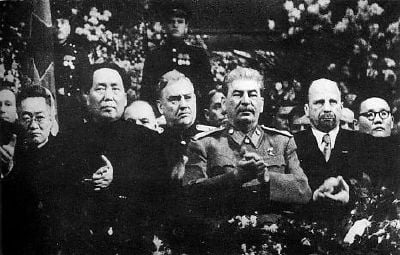
First Five-Year Plan
After consolidating his power Mao launched the First Five-Year Plan (1953–1958) which plan aimed to end Chinese dependence on agriculture in order to become a world power. With the Soviet Union's assistance, new industrial plants were built and agricultural production eventually fell to a point where industry was beginning to produce enough capital that China no longer needed the USSR's support.
Programs pursued during this time include the Hundred Flowers Campaign, in which Mao indicated his supposed willingness to consider different opinions about how China should be governed. Given the freedom to express themselves, liberal and intellectual Chinese began opposing the Communist Party and questioning its leadership. On June 8, 1957, Mao published an editorial in the Chinese Communist Party’s The People’s Daily. Mao declared that “poisonous weeds” had grown among the “fragrant flowers” within the one hundred blooming flowers of people’s criticism. Mao subsequently used the newspapers to identify individuals responsible for certain criticisms as right-wingers and counter-revolutionaries who abused the invitation given to the people to use their voice.[21] The ramifications for intellectuals who participated in criticism spanned from being harassed, labeled as rightists, or worse, counter revolutionists. Some intellectuals were subject to house arrest and forced to write confessions and self criticisms of their crimes, and others were banned from living within urban residencies and or sent for re-education. A few were executed or harassed to death.[21]
Authors such as Jung Chang have alleged that the Hundred Flowers Campaign was merely a ruse to root out "dangerous" thinking.[8]
Great Leap Forward
The success of the First-Five Year Plan encouraged Mao to instigate the Second Five-Year Plan, known as the Great Leap Forward, in January 1958. This plan was intended as an alternative model to the Soviet model for economic growth, which focused on heavy industry, advocated by others in the party. Under Mao's economic program the relatively small agricultural collectives which had been formed to date were rapidly merged into far larger people's communes, and many of the peasants were ordered to work on massive infrastructure projects and on the production of iron and steel. Some private food production was banned; livestock and farm implements were brought under collective ownership.
Mao and other party leaders ordered the new communes to implement a variety of unproven and unscientific new agricultural techniques. The diversion of labor to steel production and infrastructure projects compounded by natural disasters, such as droughts and floods, combined with these projects led to an approximately 15 percent drop in grain production in 1959 followed by a further 10 percent decline in 1960 and no recovery in 1961.[16]
In an effort to win favor with their superiors and avoid being purged, each layer in the party hierarchy exaggerated the amount of grain produced under them. Based upon the fabricated success, party cadres were ordered to requisition a disproportionately high amount of the true harvest for state use, primarily in the cities and urban areas but also for export. The net result left rural peasants with little food for themselves and many millions starved to death in what is known as the Great Chinese Famine. This famine was a cause of the death of some tens of millions Chinese peasants between 1959 and 1962.[22] Further, many children who became emaciated and malnourished during years of hardship and struggle for survival died shortly after the Great Leap Forward came to an end in 1962.[16]
The extent of Mao's knowledge of the severity of the situation has been disputed. Some believe that he may have been unaware of the extent of the famine, partly due to a reluctance to criticize his policies and decisions and the willingness of his staff to exaggerate or provide false reports regarding food production. According to his physician, Li Zhi-Sui, upon learning of the extent of the starvation, Mao vowed to stop eating meat, an action followed by his staff.[23] Others have disputed the reliability of the figures commonly cited, the qualitative evidence of a "massive death toll," and Mao's complicity in those deaths which occurred.[24]
However, Hong Kong-based historian Frank Dikötter, who conducted extensive archival research on the Great Leap Forward in local and regional Chinese government archives, challenged the notion that Mao did not know about the famine until it was too late:
The idea that the state mistakenly took too much grain from the countryside because it assumed that the harvest was much larger than it was is largely a myth—at most partially true for the autumn of 1958 only. In most cases the party knew very well that it was starving its own people to death. At a secret meeting in the Jinjiang Hotel in Shanghai dated March 25, 1959, Mao specifically ordered the party to procure up to one third of all the grain, much more than had ever been the case. At the meeting he announced that "When there is not enough to eat, people starve to death. It is better to let half of the people die so that the other half can eat their fill."[22]
Also, in Hungry Ghosts, Jasper Becker notes that Mao was dismissive of reports he received of food shortages in the countryside and refused to change course, believing that peasants were lying and that rightists and kulaks were hoarding grain. He refused to open state granaries, and instead launched a series of "anti-grain concealment" drives that resulted in numerous purges and suicides.[25] Other violent campaigns followed in which party leaders went from village to village in search of hidden food reserves, and not only grain, as Mao issued quotas for pigs, chickens, ducks and eggs. Many peasants accused of hiding food were tortured and beaten to death.[25]
The Great Leap Forward was a failure in other ways. Although the steel quotas were officially reached, almost all of the supposed steel made in the countryside was iron, as it had been made from assorted scrap metal in home-made furnaces with no reliable source of fuel such as coal. This meant that proper smelting conditions could not be achieved. According to a teacher in rural Shanghai:
We took all the furniture, pots, and pans we had in our house, and all our neighbors did likewise. We put everything in a big fire and melted down all the metal.[26]
The Great Leap Forward caused Mao to lose esteem among many of the top party cadres and was eventually forced to abandon the policy in 1962, while losing some political power to moderate leaders, perhaps most notably Liu Shaoqi and Deng Xiaoping in the process. However, Mao, supported by national propaganda, claimed that he was only partly to blame. As a result, he was able to remain Chairman of the Communist Party, with the Presidency transferred to Liu Shaoqi.
Cultural Revolution
The Cultural Revolution was initiated by Mao in 1966 to reassert his leadership after the disasters of the Great Leap Forward which led to a loss of power to reformist rivals such as Liu Shaoqi and Deng Xiaoping. State Chairman and General Secretary, respectively, they favored the idea that Mao should be removed from actual power but maintain his ceremonial and symbolic role, with the party upholding all of his positive contributions to the revolution. They attempted to marginalize Mao by taking control of economic policy and asserting themselves politically. Mao responded to Liu and Deng's movements by launching the Cultural Revolution in 1966.
Between 1966 and 1968, Mao's principal lieutenants, Defense Minister Lin Biao and Mao's wife Jiang Qing, organized a mass youth militia called the Red Guards to overthrow Mao's enemies. In the chaos and violence that ensued, much of China's artistic legacy was destroyed, millions were persecuted, some of whom lost their lives. Chaos reigned in much of the nation, and millions were persecuted, including a famous philosopher, Chen Yuen. During the Cultural Revolution, the schools in China were closed and young intellectuals living in cities were ordered to the countryside to be "re-educated" by the peasants, where they performed hard manual labor and other work.
Millions of lives were ruined during this period, as the Cultural Revolution pierced into every part of Chinese life, depicted by such Chinese films as To Live, The Blue Kite and Farewell My Concubine. It is estimated that hundreds of thousands, perhaps millions, perished in the violence of the Cultural Revolution.[27]
When Mao was informed of such losses, particularly that people had been driven to suicide, he is alleged to have commented: "People who try to commit suicide —don't attempt to save them! . . . China is such a populous nation, it is not as if we cannot do without a few people."[28] The authorities allowed the Red Guards to abuse and kill opponents of the regime. Said Xie Fuzhi, national police chief: "Don't say it is wrong of them to beat up bad persons: if in anger they beat someone to death, then so be it." As a result, in August and September 1966, there were 1,772 people murdered in Beijing alone.[28]
This period is often looked at in official circles in China and in the West as a great stagnation or even of reversal for China. While many—an estimated 100 million—did suffer,[29] some scholars, such as Lee Feigon and Mobo Gao, claim there were many great advances, and in some sectors the Chinese economy continued to outperform the west. China exploded its first H-Bomb (1967), launched the Dong Fang Hong satellite (January 30, 1970), commissioned its first nuclear submarines and made various advances in science and technology. Healthcare was free, and living standards in the countryside continued to improve.[30][4]
In 1969, Mao declared the Cultural Revolution to be over, although the official history of the People's Republic of China marks the end of the Cultural Revolution in 1976 with Mao's death. In 1972, Mao welcomed American President Richard Nixon in Beijing, signaling a policy of opening China, which was furthered under the rule of Deng Xiaoping (1978–1992).
It was during this period that Mao chose Lin Biao, who seemed to echo all of Mao's ideas, to become his successor. Lin was later officially named as Mao's successor. By 1971, however, a divide between the two men became apparent. Official history in China states that Lin was planning a military coup or an assassination attempt on Mao. Lin Biao died in a plane crash over the air space of Mongolia, presumably on his way to flee China, probably anticipating his arrest. The CPC declared that Lin was planning to depose Mao, and posthumously expelled Lin from the party. At this time, Mao lost trust in many of the top CPC figures.
Public image
Mao gave contradicting statements on the subject of personality cults. In 1955, as a response to the Khrushchev Report that criticised Joseph Stalin, Mao stated that personality cults are "poisonous ideological survivals of the old society," and reaffirmed China's commitment to collective leadership.[31] But at the 1958 Party congress in Chengdu, Mao expressed support for the personality cults of people whom he labelled as genuinely worthy figures: "Worshipping Marx, Engels, Lenin and Stalin is correct because truth is held in their hands."[32]
In 1962, Mao proposed the Socialist Education Movement (SEM) to educate the peasants . Large quantities of politicized art were produced and circulated —with Mao at the center. Numerous posters, badges and musical compositions referenced Mao in the phrase "Chairman Mao is the red sun in our hearts" (毛主席是我们心中的红太阳, Máo Zhǔxí Shì Wǒmen Xīnzhōng De Hóng Tàiyáng) and a "Savior of the people" (人民的大救星, Rénmín De Dà Jiùxīng).[33]
In October 1966, Mao's Quotations From Chairman Mao Tse-Tung, which was known as the Little Red Book was published. Party members were encouraged to carry a copy with them and possession was almost mandatory as a criterion for membership. Over the years, Mao's image became displayed almost everywhere, present in homes, offices and shops. His quotations were typographically emphasized by putting them in boldface or red type in even the most obscure writings. Music from the period emphasized Mao's stature, as did children's rhymes. The phrase "Long Live Chairman Mao for ten thousand years" was commonly heard during the era.[34]
Use of the media
Mao Zedong’s use of mass media was integral to his success. Almost immediately following the establishment of the Chinese Communist party Mao embarked on literacy campaigns, educational programs, and cultural projects throughout the entirety of China. Mandarin was proclaimed as the national spoken language and linguists were subsequently dispatched to solidify a simplified written Chinese language.[21]
Mao went to great lengths in order to ensure that his beliefs and words could find their way into the hands and minds of all Chinese people. The books Selected Works of Chairman Mao Zedong[35] or Quotations from Chairman Mao Tse-Tung[36] were published by Foreign Languages Press, Peking and distributed on an almost inconceivably large scale.[37] There were entire stockpiles of the four-volume Selected works of Mao Zedong in a variety of forms. Massive amounts of the Chinese State publishing budget was used up in producing Mao-period publications in the late 1970s. By the end of the ten-year-long Cultural Revolution it was noted by the national book store, Xinhua, that more than forty billion volumes of Mao’s works were printed and distributed; equivalent to about 15 copies of each of Mao’s books for every child, woman, and man in China.[37]
In 1979, internal estimates ranged that during the Cultural Revolution 2.2 billion portraits of the Chairman Mao Zedong had been produced. Such a number, in relation to the Chinese population at the time, is enough to provide three portraits of Mao to every single person in China.[37] Although character posters were not a new technique in China, the Cultural Revolution displayed a surge in rising form of mass media. The posters that were used by Mao, the Chinese Communist Party, and citizens proved to be a very effective tool.[21]
Under Mao’s influence the various forms of Chinese arts became a venue for mass media. Along with his use of Character Posters, Mao attempted, with moderate success, to synthesize realism with folk art in an attempt to realign art with the mass origins of the Chinese people. By the 1970s many artists had been sent out of urbanized areas and into rural locations of China in order to facilitate the “rediscovery” of Chinese origins. Such art forms as opera were changed; they adapted revolutionary lyrics to pre-existing melodies. Ballet, although not of authentic Chinese culture, was changed in order to encompass revolutionary gestures and movements.[21]
It is evident that to Mao “revolution was art; art was revolution.” The effect, intended or not, of Mao’s use of art as a form of mass media was one of the most effective forms of propaganda.[21]
Personal life
Having grown up in Hunan, Mao spoke Mandarin with a marked Hunanese accent. Ross Terrill noted Mao was a "son of the soil ... rural and unsophisticated" in origins,[2] while Clare Hollingworth asserted he was proud of his "peasant ways and manners," having a strong Hunanese accent and providing "earthy" comments on sexual matters.[38] Lee Feigon noted that Mao's "earthiness" meant that he remained connected to "everyday Chinese life."[4]
Mao's private life was very secretive at the time of his rule. However, after Mao's death, his personal physician Li Zhisui published The Private Life of Chairman Mao, a memoir which mentions some aspects of Mao's private life.[23] Li's book is regarded as controversial, especially by those sympathetic to Mao.[39] According to Li, Mao never brushed his teeth, preferring to rinse out his mouth with tea and chew the leaves. By the time of his death, his gums were severely infected and his teeth were coated with green film, with several of them coming loose. Rather than bathe, he had a servant rub him down with a hot towel. Li Zhisui described him as conducting business either in bed or by the side of the pool, preferring not to wear formal clothes unless absolutely necessary.[23]
Biographer Peter Carter noted that throughout his life, Mao had the ability to gain people's trust, and that as such he gathered around him "an extraordinarily wide range of friends" in his early years. He described Mao as having "an attractive personality" who could for much of the time be a "moderate and balanced man," but noted that he could also be ruthless, and showed no mercy to his opponents.[5] This description was echoed by Sinologist Stuart Schram, who emphasized Mao's ruthlessness, but who also noted that he showed no sign of taking pleasure in torture or killing in the revolutionary cause.[1] Lee Feigon considered Mao "draconian and authoritarian" when threatened, but opined that he was not the "kind of villain that his mentor Stalin was."[4] Alexander Pantsov and Steven I. Levine claimed that Mao was a "man of complex moods," who "tried his best to bring about prosperity and gain international respect" for China, being "neither a saint nor a demon." They noted that in early life, he strove to be "a strong, wilful, and purposeful hero, not bound by any moral chains," and that he "passionately desired fame and power."[3]
Death and aftermath
In the last years of his life, Mao was faced with declining health due to either Parkinson's disease or, according to his physician, amyotrophic lateral sclerosis,[23] as well as lung ailments due to smoking and heart trouble. Some also attributed Mao's decline in health to the betrayal of Lin Biao. Mao's last public appearance was on May 27, 1976, where he met the visiting Pakistani Prime Minister Zulfikar Ali Bhutto during the latter's one-day visit to Beijing.
Mao suffered two major heart attacks in 1976, one in March and another in July, before a third struck on September 5, rendering him an invalid. Mao Zedong died nearly four days later just after midnight on September 9, 1976, at age 82.
His body lay in state at the Great Hall of the People. There was a three-minute silence observed during this service. His body was later placed into the Mausoleum of Mao Zedong in Beijing.
As anticipated after Mao's death, there was a power struggle for control of China. On one side was the left wing led by the Gang of Four, who wanted to continue the policy of revolutionary mass mobilization. On the other side was the right wing opposing these policies. Among the latter group, the right wing restorationists, led by Chairman Hua Guofeng, advocated a return to central planning along the Soviet model, whereas the right wing reformers, led by Deng Xiaoping, wanted to overhaul the Chinese economy based on market-oriented policies and to de-emphasize the role of Maoist ideology in determining economic and political policy. Eventually, the reformers won control of the government. Deng Xiaoping, with clear seniority over Hua Guofeng, defeated Hua in a bloodless power struggle a few years later.
Legacy
A highly controversial figure, Mao is regarded as one of the most important individuals in modern world history. Supporters regard him as a great leader and credit him with numerous accomplishments including modernizing China and building it into a world power, promoting the status of women, improving education and health care, providing universal housing, and increasing life expectancy as China's population grew from around 550 to over 900 million during the period of his leadership.[30][40] [41] Maoists furthermore promote his role as theorist, statesman, poet, and visionary: "Mao had an extraordinary mix of talents: he was visionary, statesman, political and military strategist of cunning intellect, a philosopher and poet."[12]
In contrast, critics have characterized him as a dictator who oversaw systematic human rights abuses, and whose rule is estimated to have contributed to the deaths of 40–70 million people through starvation, forced labor, and executions, ranking his tenure as the top incidence of democide in human history.[42][43] Mao has been called "one of the great tyrants of the twentieth century," and a dictator comparable to Adolf Hitler and Joseph Stalin,[28][44] with a death toll surpassing both.[43]
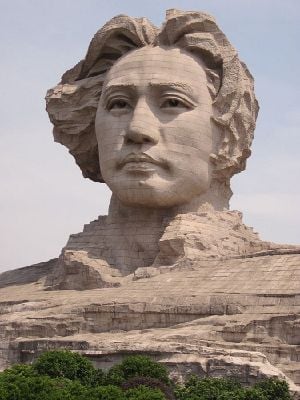
Mao was frequently likened to China's First Emperor Qin Shi Huang, notorious for burying alive hundreds of scholars, and personally enjoyed the comparison.[28] During a speech to party cadre in 1958, Mao said he had far outdone Qin Shi Huang in his policy against intellectuals: "He buried 460 scholars alive; we have buried forty-six thousand scholars alive ... You [intellectuals] revile us for being Qin Shi Huangs. You are wrong. We have surpassed Qin Shi Huang a hundredfold."[45]
As a result of such tactics, critics have pointed out that:
The People's Republic of China under Mao exhibited the oppressive tendencies that were discernible in all the major absolutist regimes of the twentieth century. There are obvious parallels between Mao's China, Nazi Germany and Soviet Russia. Each of these regimes witnessed deliberately ordered mass 'cleansing' and extermination.[44]
Others, such as Philip Short, reject such comparisons in Mao: A Life, arguing that whereas the deaths caused by Nazi Germany and Soviet Russia were largely systematic and deliberate, the overwhelming majority of the deaths under Mao were unintended consequences of famine.[12] Instead, Short compared Mao with nineteenth-century Chinese reformers who challenged China's traditional beliefs in the era of China's clashes with Western colonial powers. Short argues:
Mao's tragedy and his grandeur were that he remained to the end in thrall to his own revolutionary dreams ... He freed China from the straitjacket of its Confucian past, but the bright Red future he promised turned out to be a sterile purgatory.[12]
Mao's English interpreter Sidney Rittenberg wrote in his memoir The Man Who Stayed Behind that whilst Mao "was a great leader in history," he was also "a great criminal because, not that he wanted to, not that he intended to, but in fact, his wild fantasies led to the deaths of tens of millions of people."[46] Li Rui, Mao's personal secretary, goes further and claims he was dismissive of the suffering and death caused by his policies: "Mao's way of thinking and governing was terrifying. He put no value on human life. The deaths of others meant nothing to him."[47]
In their 832-page biography, Mao: The Unknown Story, Jung Chang and Jon Halliday take a very critical view of Mao's life and influence. For example, they note that Mao was well aware that his policies would be responsible for the deaths of millions; While discussing labor-intensive projects such as waterworks and making steel, Mao said to his inner circle in November 1958: "Working like this, with all these projects, half of China may well have to die. If not half, one-third, or one-tenth—50 million—die."[8]
Jasper Becker and Frank Dikötter offer a similarly abysmal appraisal:
[A]rchive material gathered by Dikötter ... confirms that far from being ignorant or misled about the famine, the Chinese leadership were kept informed about it all the time. And he exposes the extent of the violence used against the peasants."[48]
Mao also gave the impression that he might even welcome a nuclear war, although historians dispute the sincerity of his words, some claiming him to be "was deadly serious,"[49] while others say "He was bluffing ... the sabre-rattling was to show that he, not Khrushchev, was the more determined revolutionary."[22]
"Let us imagine how many people would die if war breaks out. There are 2.7 billion people in the world, and a third could be lost. If it is a little higher, it could be half ... I say that if the worst came to the worst and one-half dies, there will still be one-half left, but imperialism would be razed to the ground and the whole world would become socialist. After a few years there would be 2.7 billion people again."[22]
Mao's revolutionary tactics continue to be used by insurgents, and his political ideology continues to be embraced by many communist organizations around the world. The ideology of Maoism has influenced many communists, mainly in the Third World, including revolutionary movements such as Cambodia's Khmer Rouge, Peru's Shining Path, and the Nepalese revolutionary movement.[50]
Mao's supporters claim that he rapidly industrialized China. Mobo Gao, in his 2008 book The Battle for China's Past: Mao and the Cultural Revolution, credits Mao for bringing "unity and stability to a country that had been plagued by civil wars and foreign invasions," and laying the foundation for China to "become the equal of the great global powers".[30] However, others have claimed that his policies, particularly the controversially named 'Great Leap Forward' and the Cultural Revolution, were impediments to industrialization and modernization. His supporters claim that his policies laid the groundwork for China's later rise to become an economic superpower, while others claim that his policies delayed economic development and that China's economy only underwent its rapid growth after Mao's policies had been widely abandoned.
In mainland China, Mao is still revered by many supporters of the Communist Party and respected by the majority of the general population. For its part, the Chinese government continues to officially regard Mao as a national hero. In 2008, China opened the Mao Zedong Square to visitors in his hometown of central Hunan Province to mark the 115th anniversary of his birth.[51]
However, Mao has many Chinese critics, both those who live inside and outside China. Opposition to Mao is subject to restriction and censorship in mainland China, but is especially strong elsewhere, where he is often reviled as a brutish ideologue. In the West, his name is generally associated with tyranny and his economic theories are widely discredited—though to some political activists he remains a symbol against capitalism, imperialism, and western influence. Even in China, key pillars of his economic theory have been largely dismantled by market reformers like Deng Xiaoping and Zhao Ziyang, who succeeded him as leaders of the Communist Party.
Mao continues to have a presence in China and around the world in popular culture, where his face adorns everything from t-shirts to coffee cups. Mao's granddaughter, Kong Dongmei, defended the phenomenon, stating that "it shows his influence, that he exists in people's consciousness and has influenced several generations of Chinese people's way of life. Just like Che Guevara's image, his has become a symbol of revolutionary culture."[46]
Writings and calligraphy
Mao was a prolific writer of political and philosophical literature.[52] He is the attributed author of Quotations From Chairman Mao Tse-Tung, known in the West as the "Little Red Book" and in Cultural Revolution China as the "Red Treasure Book" (红宝书): this is a collection of short extracts from his speeches and articles, edited by Lin Biao and ordered topically. Mao wrote several other philosophical treatises, both before and after he assumed power. These include:
- On Guerrilla Warfare (《游击战》); 1937
- On Practice (《实践论》); 1937
- On Contradiction (《矛盾论》); 1937
- On Protracted War (《论持久战》); 1938
- In Memory of Norman Bethune (《纪念白求恩》); 1939
- On New Democracy (《新民主主义论》); 1940
- Talks at the Yan'an Forum on Literature and Art (《在延安文艺座谈会上的讲话》); 1942
- Serve the People (《为人民服务》); 1944
- The Foolish Old Man Who Removed the Mountains (《愚公移山》); 1945
- On the Correct Handling of the Contradictions Among the People (《正确处理人民内部矛盾问题》); 1957
Some of Mao's most well-known poems are: Changsha (1925), The Double Ninth (1929), Loushan Pass (1935), The Long March (1935), Snow (1936), The PLA Captures Nanjing (1949), Reply to Li Shuyi (1957), and Ode to the Plum Blossom (1961).
Mao was also a skilled Chinese calligrapher with a highly personal style. His calligraphy can be seen today throughout mainland China.[53] His work gave rise to a new form of Chinese calligraphy called "Mao-style" or Maoti, which has gained increasing popularity since his death.
Portrayal in film and television
Mao has been portrayed in film and television numerous times. Some notable actors include:
- Han Shi, the first actor ever to have portrayed Mao, in a 1978 drama Dielianhua and later again in a 1980 film Cross the Dadu River;[54]
- Gu Yue, who portrayed Mao 84 times on screen throughout his 27-year career and won the Best Actor title at the Hundred Flowers Awards in 1990 and 1993;[55]
- Liu Ye, who played a young Mao in The Founding of a Party (2011);[56]
- Tang Guoqiang, who portrayed Mao in more recent times, in the films The Long March (1996) and The Founding of a Republic (2009), and the television series Huang Yanpei (2010), among others.
Genealogy
- Ancestors
- Máo Yíchāng (毛贻昌, born Xiangtan October 15, 1870, died Shaoshan January 23, 1920), father, courtesy name Máo Shùnshēng (毛顺生) or also known as Mao Jen-sheng
- Wén Qīmèi(文七妹, born Xiangxiang 1867, died October 5, 1919), mother. She was illiterate and a devout Buddhist. She was a descendant of Wen Tianxiang.
- Máo Ēnpǔ (毛恩普, born May 22, 1846, died November 23, 1904), paternal grandfather
- Luó Shì (罗氏), paternal grandmother
- Máo Zǔrén (毛祖人), paternal great-grandfather
- Siblings
Mao had several siblings. His parents altogether had five sons and two daughters plus one adopted daughter. Two of the sons and both daughters died young, leaving the three brothers Mao Zedong, Mao Zemin, and Mao Zetan, and the adopted daughter Mao Zejian. Note that the character zé (泽) appears in all of the siblings' given names. This is a common Chinese naming convention.
- Mao Zemin (毛泽民, 1895–1943), younger brother, executed by a warlord
- Mao Zetan (毛泽覃, 1905–1935), younger brother, executed by the KMT
- Mao Zejian (毛泽建, 1905–1929), adopted sister, executed by the KMT
Zemin's son, Mao Yuanxin, was raised by Mao Zedong's family. He became Mao Zedong's liaison with the Politburo in 1975.
- Wives
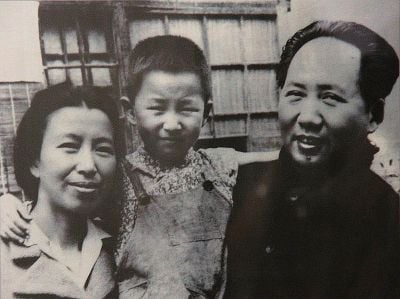
Mao Zedong had four wives who gave birth to a total of ten children:
- Luo Yixiu (罗一秀, October 20, 1889 – 1910) of Shaoshan: married 1907 to 1910
- Yang Kaihui (杨开慧, 1901–1930) of Changsha: married 1921 to 1927, executed by the KMT in 1930; mother to Mao Anying, Mao Anqing, and Mao Anlong
- He Zizhen (贺子珍, 1910–1984) of Jiangxi: married May 1928 to 1939; mother to Mao Anhong, Li Min, and four other children
- Jiang Qing: (江青, 1914–1991), married 1939 to Mao's death; mother to Li Na
- Children
Mao Zedong had a total of ten children,[16] including:
- Mao Anying (毛岸英, 1922–1950): son to Yang, married to Liú Sīqí (刘思齐), who was born Liú Sōnglín (刘松林), killed in action during the Korean War
- Mao Anqing (毛岸青, 1923–2007): son to Yang, married to Shao Hua (邵华), grandson Mao Xinyu (毛新宇), great-grandson Mao Dongdong
- Mao Anlong (1927–1931): son to Yang, died during the Chinese Civil War
- Mao Anhong (1932-1935?): son to He, left to Mao's younger brother Zetan and then to one of Zetan's guards when he went off to war, was never heard of again
- Li Min (李敏, b. 1936): daughter to He, married to Kǒng Lìnghuá (孔令华), son Kǒng Jìníng (孔继宁), daughter Kǒng Dōngméi (孔冬梅)
- Li Na (李讷, Pinyin: Lĭ Nà, b. 1940): daughter to Jiang (whose birth given name was Li, a name also used by Mao while evading the KMT), married to Wáng Jǐngqīng (王景清), son Wáng Xiàozhī (王效芝)
Mao's first and second daughters were left to local villagers because it was too dangerous to raise them while fighting the Kuomintang and later the Japanese. Their youngest daughter (born in early 1938 in Moscow after Mao separated) and one other child (born 1933) died in infancy.
Notes
- ↑ 1.00 1.01 1.02 1.03 1.04 1.05 1.06 1.07 1.08 1.09 1.10 1.11 1.12 1.13 1.14 1.15 1.16 Stuart R. Schram, Mao Tse-tung (Penguin Books, 1967, ISBN 978-0140208405).
- ↑ 2.0 2.1 2.2 2.3 2.4 2.5 Ross Terrill, Mao: A Biography (Stanford University Press, 2000, ISBN 978-0804729215).
- ↑ 3.00 3.01 3.02 3.03 3.04 3.05 3.06 3.07 3.08 3.09 3.10 Alexander V. Pantsov and Steven I. Levine, Mao: The Real Story (Simon & Schuster, 2012, ISBN 978-1451654479).
- ↑ 4.00 4.01 4.02 4.03 4.04 4.05 4.06 4.07 4.08 4.09 4.10 4.11 4.12 4.13 Lee Feigon, Mao: A Reinterpretation (Ivan R. Dee, 2002, ISBN 978-1566634588).
- ↑ 5.0 5.1 5.2 5.3 5.4 5.5 5.6 Peter Carter, Mao (Oxford University Press, 1976, ISBN 978-0192731401).
- ↑ Siao Yu (Xiao Yu), Mao Tse-Tung and I Were Beggars (Syracuse, NY: Syracuse University Press, 1959, ISBN 978-0815600152).
- ↑ Barbara Barnouin and Changgen Yu, Zhou Enlai: A Political Life (The Chinese University Press, 2007, ISBN 978-9629962807).
- ↑ 8.0 8.1 8.2 Jung Chang and Jon Halliday, Mao: The Unknown Story (Jonathan Cape, 2003, ISBN 978-0224071260).
- ↑ Dorothy Perkins (ed.), Encyclopedia of China: History and Culture (Routledge 1998, ISBN 978-1579581107).
- ↑ 10.0 10.1 10.2 10.3 Sam van Schaik, Tibet: A History (Yale University Press, 2011, ISBN 978-0300154047).
- ↑ Laurie Burkitt, Andrew Scobell, and Larry M. Wortzel (eds.), The lessons of history: The Chinese people's Liberation Army at 75 (Strategic Studies Institute, 2003, ISBN 978-1584871262).
- ↑ 12.0 12.1 12.2 12.3 12.4 12.5 Philip Short, Mao: A Life (Henry Holt and Co., 2000, ISBN 978-0805031157).
- ↑ 13.0 13.1 13.2 Kuisong Yang, "Reconsidering the Campaign to Suppress Counterrevolutionaries" The China Quarterly 193 (March 2008): 102-121. Retrieved June 12, 2023.
- ↑ 14.0 14.1 Steven W. Mosher, China Misperceived: American Illusions and Chinese Reality (Basic Books, 1992, ISBN 978-0465098132).
- ↑ Stephen Rosskamm Shalom, Deaths in China Due to Communism (Center for Asian Studies, Arizona State University, 1984, ISBN 978-0939252114).
- ↑ 16.0 16.1 16.2 16.3 Jonathan Spence, Mao Zedong: A Life (Penguin Books, 2006, ISBN 978-0143037729).
- ↑ Roderick MacFarquhar and John K. Fairbank (eds.), The Cambridge History of China (Cambridge University Press, 1987, ISBN 978-0521243360).
- ↑ Maurice Meisner, Mao's China and After: A History of the People's Republic (Free Press, 1999, ISBN 978-0684856353).
- ↑ Benjamin A. Valentino, Final Solutions: Mass Killing and Genocide in the Twentieth Century (Cornell University Press, 2004, ISBN 978-0801439650).
- ↑ John Fairbank and Merle Goldman, China: A New History (Cambridge: The Belknap Press of Harvard University Press, 2006, ISBN 978-0674018280).
- ↑ 21.0 21.1 21.2 21.3 21.4 21.5 Rebecca E. Karl, Mao Zedong and China in the Twentieth-Century World: A Concise History (Duke University Press Books, 2010, ISBN 978-0822347958).
- ↑ 22.0 22.1 22.2 22.3 Frank Dikötter, Mao's Great Famine: The History of China's Most Devastating Catastrophe, 1958-1962 (Walker Books, 2010, ISBN 978-0802777683).
- ↑ 23.0 23.1 23.2 23.3 Li Zhi-Sui, The Private Life of Chairman Mao (RandomHouse, 1996, ISBN 978-0679764434).
- ↑ Joseph Ball, Did Mao Really Kill Millions in the Great Leap Forward? Monthly Review (September 21, 2006). Retrieved June 12, 2023.
- ↑ 25.0 25.1 Jasper Becker, Hungry Ghosts (Free Press, 1997, ISBN 978-0684834573).
- ↑ Beth Macy, Factory Man: How One Furniture Maker Battled Offshoring, Stayed Local - and Helped Save an American Town (Little, Brown and Company, 2014, ISBN 978-0316231435).
- ↑ Source List and Detailed Death Tolls for the Twentieth Century Hemoclysm Historical Atlas of the Twentieth Century. Retrieved June 12, 2023.
- ↑ 28.0 28.1 28.2 28.3 Roderick MacFarquhar and Michael Schoenhals, Mao's Last Revolution (Belknap Press of Harvard University Press, 2006, ISBN 978-0674023321).
- ↑ Daniel Chirot, Modern Tyrants: The Power and Prevalence of Evil in Our Age (Princeton University Press, 1996).
- ↑ 30.0 30.1 30.2 Mobo Gao, The Battle for China's Past: Mao and the Cultural Revolution (London: Pluto Press, 2008, ISBN 978-0745327808).
- ↑ Maurice Meisner, Mao Zedong: A Political and Intellectual Portrait (Polity, 2007, ISBN 978-0745631073).
- ↑ Glenn Kucha and Jennifer Llewellyn, https://alphahistory.com/chineserevolution/cult-of-mao/ The Cult of Mao] Alpha History. Retrieved June 12, 2023.
- ↑ Helen Wang, Chapter 5: "Mao Badges – Visual Imagery and Inscriptions" Chairman Mao Badges: Symbols and Slogans of the Cultural Revolution (British Museum Press, 2008, ISBN 0861591690).
- ↑ Xing Lu, Rhetoric of the Chinese Cultural Revolution: The Impact on Chinese Thought, Culture, and Communication (University of South Carolina Press, 2004, ISBN 978-1570035432).
- ↑ Selected Works of Chairman Mao Zedong Marxists.org. Retrieved June 12, 2023.
- ↑ Quotations From Chairman Mao Tse-Tung (China Books & Periodicals; Reissue edition, 1990, ISBN 978-0835123884).
- ↑ 37.0 37.1 37.2 Geremie Barme, Shades of Mao: The Posthumous Cult of the Great Leader (Routledge, 1996, ISBN 978-1563246791).
- ↑ Clare Hollingworth, Mao and the Men Against Him (Jonathan Cape, Pub., 1985, ISBN 978-0224017602).
- ↑ See for example, Q.M. DeBorja and Xu L. Dong (eds), Manufacturing History: Sex, Lies and Random House's Memoirs of Mao's Physician (NY: China Study Group, 1996).
- ↑ Patricia Buckley Ebrey, The Cambridge Illustrated History of China (Cambridge University Press, 2010, ISBN 978-0521124331).
- ↑ Patrick O'Brien, Concise Atlas of World History (Oxford University Press, 2002, ISBN 978-0195219210).
- ↑ Daniel Jonah Goldhagen, Worse Than War: Genocide, Eliminationism, and the Ongoing Assault on Humanity (PublicAffairs, 2009, ISBN 978-1586487690).
- ↑ 43.0 43.1 Jonathan Fenby, Modern China: The Fall and Rise of a Great Power, 1850 to the Present (Ecco, 2008, ISBN 978-0061661167).
- ↑ 44.0 44.1 Michael Lynch, Mao (Routledge Historical Biographies) (Routledge, 2004, ISBN 978-0415215787).
- ↑ Kenneth Lieberthal, Governing China: From Revolution Through Reform (W. W. Norton & Company, 2003, ISBN 0393924920).
- ↑ 46.0 46.1 Maxim Duncan, [hhttps://www.reuters.com/article/idINIndia-42756920090928 Granddaughter Keeps Mao's Memory Alive in Bookshop] Reuters (September 28, 2009). Retrieved June 12, 2023.
- ↑ Jonathan Watts, China must confront dark past, says Mao confidant The Guardian (June 2, 2005). Retrieved June 12, 2023.
- ↑ Jasper Becker, Systematic genocide The Spectator (September 25, 2010). Retrieved June 12, 2023.
- ↑ Robert Service, Comrades!: A History of World Communism (Harvard University Press, 2007, ISBN 978-0674025301).
- ↑ Robert J. Alexander, International Maoism in the Developing World (Praeger, 1999, ISBN 978-0275961497).
- ↑ Chairman Mao square opened on his 115th birth anniversary China Daily (December 25, 2008). Retrieved June 12, 2023.
- ↑ Mao Zedong Thought – Part 1 Chinese Posters. Retrieved June 12, 2023.
- ↑ Yuehping Yen, Calligraphy and Power in Contemporary Chinese Society (Routledge, 2014, ISBN 978-0415646369).
- ↑ Being Mao Zedong Global Times (July 4, 2011). Retrieved June 12, 2023.
- ↑ Gu Yue Dead at 68 China Daily (July 5, 2005). Retrieved June 12, 2023.
- ↑ Wei Liu, The reel Mao China Daily European Weekly (June 3, 2011). Retrieved June 12, 2023.
ReferencesISBN links support NWE through referral fees
- Alexander, Robert J. International Maoism in the Developing World. Praeger, 1999. ISBN 978-0275961497
- Barme, Geremie. Shades of Mao: The Posthumous Cult of the Great Leader. Routledge, 1996, ISBN 978-1563246791
- Barnouin, Barbara, and Changgen Yu. Zhou Enlai: A Political Life. The Chinese University Press, 2007. ISBN 978-9629962807
- Becker, Jasper. Hungry Ghosts. Free Press, 1997. ISBN 978-0684834573
- Burkitt, Laurie, Andrew Scobell, and Larry M. Wortzel (eds.). The lessons of history: The Chinese people's Liberation Army at 75. Strategic Studies Institute, 2003. ISBN 978-1584871262
- Carter, Peter. Mao. Oxford University Press, 1976. ISBN 978-0192731401
- Chang, Jung, and Jon Halliday. Mao: The Unknown Story. Jonathan Cape, 2003. ISBN 978-0224071260
- Cheek, Timothy. Mao Zedong and China's Revolutions: A Brief History with Documents. Bedford/St. Martin's, 2002. ISBN 978-0312256265
- Chirot, Daniel. Modern Tyrants: The Power and Prevalence of Evil in Our Age. Princeton University Press, 1996. ASIN B00FDVNJGS
- DeBorja, Q.M., and Xu L. Dong (eds). Manufacturing History: Sex, Lies and Random House's Memoirs of Mao's Physician. NY: China Study Group, 1996. ASIN B000MGVPCO
- Dikötter, Frank. Mao's Great Famine: The History of China's Most Devastating Catastrophe, 1958-1962. Walker Books, 2010. ISBN 978-0802777683
- Ebrey, Patricia Buckly. The Cambridge Illustrated History of China. Cambridge University Press, 2010. ISBN 978-0521124331
- Fairbank, John, and Merle Goldman. China: A New History. Cambridge: The Belknap Press of Harvard University Press, 2006. ISBN 978-0674018280
- Feigon, Lee. Mao: A Reinterpretation. Ivan R. Dee, 2002. ISBN 978-1566634588
- Fenby, Jonathan. Modern China: The Fall and Rise of a Great Power, 1850 to the Present. Ecco, 2008. ISBN 978-0061661167
- Gao, Mobo. The Battle for China's Past: Mao and the Cultural Revolution. London: Pluto Press, 2008. ISBN 978-0745327808
- Goldhagen, Daniel Jonah. Worse Than War: Genocide, Eliminationism, and the Ongoing Assault on Humanity. PublicAffairs, 2009. ISBN 978-1586487690
- Hollingworth, Clare. Mao and the Men Against Him. Jonathan Cape, Pub., 1985. ISBN 978-0224017602
- Karl, Rebecca E. Mao Zedong and China in the Twentieth-Century World: A Concise History. Duke University Press Books, 2010. ISBN 978-0822347958
- Li Zhi-Sui. The Private Life of Chairman Mao. RandomHouse, 1996. ISBN 978-0679764434
- Lieberthal, Kenneth. Governing China: From Revolution Through Reform. W. W. Norton & Company, 2003. ISBN 0393924920
- Lu, Xing. Rhetoric of the Chinese Cultural Revolution: The Impact on Chinese Thought, Culture, and Communication. University of South Carolina Press, 2004. ISBN 978-1570035432
- Lynch, Michael. Mao (Routledge Historical Biographies). Routledge, 2004. ISBN 978-0415215787
- MacFarquhar, Roderick, and John K. Fairbank (eds.). The Cambridge History of China. Cambridge University Press, 1987. ISBN 978-0521243360
- MacFarquhar, Roderick, and Michael Schoenhals. Mao's Last Revolution. Belknap Press of Harvard University Press, 2006. ISBN 978-0674023321
- Macy, Beth. Factory Man: How One Furniture Maker Battled Offshoring, Stayed Local - and Helped Save an American Town. Little, Brown and Company, 2014. ISBN 978-0316231435
- Meisner, Maurice. Mao's China and After: A History of the People's Republic. Free Press, 1999. ISBN 978-0684856353
- Meisner, Maurice. Mao Zedong: A Political and Intellectual Portrait. Polity, 2007. ISBN 978-0745631073
- Mosher, Stephen W. China Misperceived: American Illusions and Chinese Reality. Basic Books, 1992. ISBN 978-0465098132
- O'Brien, Patrick. Concise Atlas of World History. Oxford University Press, 2002. ISBN 978-0195219210
- Panné, Jean-Louis, Andrzej Paczkowski, Karel Bartosek, Jean-Louis Margolin, Nicolas Werth, and Stéphane Courtois. The Black Book of Communism: Crimes, Terror, Repression. Harvard University Press, 1999. ISBN 978-0674076082
- Pantsov, Alexander V., and Steven I. Levine. Mao: The Real Story. Simon & Schuster, 2012. ISBN 978-1451654479
- Perkins, Dorothy (ed.). Encyclopedia of China: History and Culture. Routledge 1998. ISBN 978-1579581107
- Perry, Elizabeth J. Anyuan: Mining China's Revolutionary Tradition. University of California Press, 2012. ISBN 978-0520271906
- Schaik, Sam van. Tibet: A History. Yale University Press, 2011. ISBN 978-0300154047
- Schram, Stuart R. Mao Tse-tung. Penguin Books, 1967. ISBN 978-0140208405
- Service, Robert. Comrades!: A History of World Communism. Harvard University Press, 2007. ISBN 978-0674025301
- Shalom, Stephen Rosskamm. Deaths in China Due to Communism. Center for Asian Studies, Arizona State University, 1984. ISBN 978-0939252114
- Short, Philip. Mao: A Life. Henry Holt and Co., 2000. ISBN 978-0805031157
- Siao Yu (Xiao Yu). Mao Tse-Tung and I Were Beggars. Syracuse, NY: Syracuse University Press, 1959. ISBN 978-0815600152
- Spence, Jonathan. Mao Zedong: A Life. Penguin Books, 2006. ISBN 978-0143037729
- Terrill, Ross. Mao: A Biography. Stanford University Press, 2000. ISBN 978-0804729215
- Valentino, Benjamin A. Final Solutions: Mass Killing and Genocide in the Twentieth Century. Cornell University Press, 2004. ISBN 978-0801439650
- Wang, Helen. Chairman Mao Badges: Symbols and Slogans of the Cultural Revolution British Museum Press, 2008. ISBN 0861591690
- Yen, Yuehping. Calligraphy and Power in Contemporary Chinese Society. Routledge, 2014. ISBN 978-0415646369
External links
All links retrieved April 29, 2025.
- Quotations from Chairman Mao Tse-tung
- Mao Zedong Reference Archive Marxists.org
- China must confront dark past, says Mao confidant The Guardian
- Mao was cruel – but also laid the ground for today's China The Guardian
- Comrade Mao - 44 Chinese posters of the 1950s - 70s
- On the Role of Mao Zedong Live Journal
- Remembering Mao's Victims Spiegel International
- Finding the Facts About Mao's Victims The New York Review
- Remembering China's Great Helmsman Huff Post
| Party Political Offices | ||
|---|---|---|
| Communist Party of China | ||
| Preceded by: Zhu De |
Chairman of the CPC Central Military Commission 1936–1949 |
Succeeded by: Himself |
| Preceded by: Zhang Wentian |
Leader of the Communist Party of China 1943–1976 |
Succeeded by: Hua Guofeng |
| Post established | Chairman of the Central Committee of the Communist Party of China 1945–1976 | |
| Preceded by: Himself |
Chairman of the CPC Central Military Commission 1954–1976 |
Succeeded by: Hua Guofeng |
| Political offices | ||
| Chinese Soviet Republic | ||
| New Title | Chairman of the Central Executive Committee of the Chinese Soviet Republic 1931–1937 |
Chinese Soviet Republic disbanded |
| Chairman of the Council of People's Commissars of the Chinese Soviet Republic 1931–1934 |
Succeeded by: Zhang Wentian | |
| People's Republic of China | ||
| New Title | Chairman of the National Committee of the Chinese People's Political Consultative Conference 1949–1954 |
Succeeded by: Zhou Enlai |
| Chairman of the Central People's Government of the People's Republic of China 1949–1954 |
Succeeded by: Himself | |
| Chairman of the People's Revolutionary Military Council of the Central People's Government 1949–1954 |
Succeeded by: Himself | |
| Preceded by: Himself |
Chairman of the People's Republic of China 1954–1959 |
Succeeded by: Liu Shaoqi |
| Academic offices | ||
| Preceded by: Deng Fa |
President of the CPC Central Party School 1943–1947 |
Succeeded by: Liu Shaoqi |
Credits
New World Encyclopedia writers and editors rewrote and completed the Wikipedia article in accordance with New World Encyclopedia standards. This article abides by terms of the Creative Commons CC-by-sa 3.0 License (CC-by-sa), which may be used and disseminated with proper attribution. Credit is due under the terms of this license that can reference both the New World Encyclopedia contributors and the selfless volunteer contributors of the Wikimedia Foundation. To cite this article click here for a list of acceptable citing formats.The history of earlier contributions by wikipedians is accessible to researchers here:
The history of this article since it was imported to New World Encyclopedia:
Note: Some restrictions may apply to use of individual images which are separately licensed.
